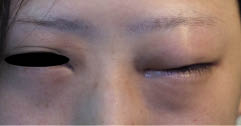Aya Kobayashi, Hisashi Uhara*, Atsuko Ashida, Yukiko Kiniwa and Ryuhei Okuyama
Department of Dermatology, Shinshu University School of Medicine, 3-1-1 Asahi, Matsumoto 390-8621, Japan. *E-mail: uhara@shinshu-u.ac.jp
Accepted September 17, 2010.
Aya Kobayashi, Hisashi Uhara*, Atsuko Ashida, Yukiko Kiniwa and Ryuhei Okuyama
Department of Dermatology, Shinshu University School of Medicine, 3-1-1 Asahi, Matsumoto 390-8621, Japan. *E-mail: uhara@shinshu-u.ac.jp
Accepted September 17, 2010.
Although angiooedema is caused by C1 inhibitor deficiency, drugs and various disease, cases linked only to physical irritation are extremely rare. We report here a case of thermal angiooedema caused by showering in hot water.
CASE REPORT
A 20-year-old Japanese woman presented with a 1-year history of recurrent episodes of eyelid swelling without major urticaria. The swelling occurred only when she took a hot shower or bath. Symptoms lasted for a few days and improved spontaneously. On one occasion, respiratory discomfort accompanied the eyelid swelling. The patient was consuming no agents associated with such episodes, including foods, medicines or supplements, although she did have a history of childhood atopic dermatitis and bronchial asthma. She had also suffered a single episode of oral allergy to kiwi fruit without major urticaria or angiooedema. She had no history of cholinergic or physical urticaria linked to cold, solar radiation, contact heat, vibration or water. Nor did she have a family history of angiooedema. In laboratory examinations, the results of a blood cell count and serum protein electrophoresis, and measurements of immunoglobulin E, C-reactive protein, hepatic enzymes, C1 inhibitor activity, C1q, C3 and C4 all fell within their respective normal ranges. Anti-nuclear antibody was negative. Renal function and thyroid function were normal. These findings suggested that her episodes may have been physically induced by hot water. A challenge test was therefore performed. First, the patient’s forearm was locally warmed with a tube filled with hot water (50°C, 5 min). However, no symptoms occurred. Next, she took a shower at 38°C, with the temperature of the water being gradually increased. After showering at 41°C for a few minutes, she complained of itching affecting both eyelids, which immediately began to swell (Fig. 1). Other symptoms, including urticaria and respiratory discomfort, did not occur. The patient was treated with chlorpheniramine and olopatadine hydrochloride, but the swelling continued for two days. Her serum concentrations of histamine before the test and 20 min after symptoms developed were 0.70 and 0.92 ng/ml, respectively (normal range: 0.18 ng/ml). In a third test, the patient took a shower 6 h after administration of olopatadine hydrochloride. No symptoms developed, even with a water temperature of 42°C.

Fig. 1. Swelling of both eyelids induced by showering at 41°C for a few minutes.
DISCUSSION
Angiooedema is a localised short-lasting swelling of the skin and mucosal tissues. C1 inhibitor deficiency (hereditary and acquired), drugs (angiotensin converting enzyme (ACE) inhibitors, angiotensin receptor blockers, aspirin, NSAIDs), and concomitant conditions (infection, autoimmune disorder, other illnesses) can cause the observed symptoms (1–3). Angiooedema without urticaria accounts for about 10% of the total number of cases of urticaria and angiooedema (4, 5). Cases linked to physical irritation are extremely rare. Zingale et al. (2) described the pathogenic characteristics in 776 cases of angiooedema without major urticaria as follows: unknown origin, 38%; C1 inhibitor deficiency, 25%; exogenous stimulus, 16%; ACE inhibitor, 11%; and autoimmune disease or infection, 7%. They also reported the frequencies of each type of exogenous stimulus in 124 cases as follows: medication 45%; food 36%; both 8%; insect bite 4%; other environmental allergens 3%; and other minor stimuli, including physical irritation 3%. The details of the cases linked to minor stimuli were not described.
The histamine levels in our patient were already elevated before challenge and did not increase markedly 20 min after the symptoms developed. Although we lack sufficient data to explain the reason for this, her histamine levels may have been constantly high. Moreover, since the half-life of histamine in the serum is very short, we may have detected a significant increase in her histamine levels if we had measured them immediately after the symptoms developed.
Recently, recommendations for diagnostic testing of physical urticaria have been reported (6, 7). The result of the challenge test in our case indicated that angiooedema was induced by hot showering of the whole body rather than a local increase in temperature. In addition, while the symptoms were blocked by the preventive administration of an antihistamine, antihistamine administration after symptoms had developed produced no improvements. Although we have no evidence to prove it, this phenomenon does suggest that antihistamines may inhibit early reactions induced by histamine, but not later reactions that are probably caused by other chemical mediators and complement activation.
Investigations of cases of angiooedema should be tailored to each patient’s symptoms. The challenge test is important for determining the cause of the symptoms and for therapeutic planning.
The authors declare no conflict of interest.
References
